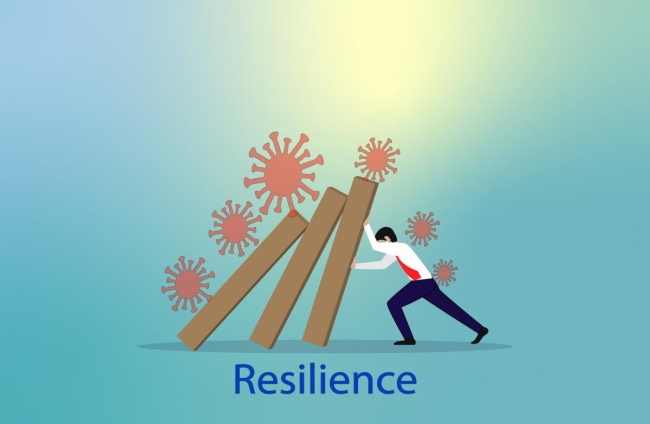You have /5 articles left.
Sign up for a free account or log in.

Maria Stavreva/DigitalVision Vectors/Getty Images
Emotional stress is now the top reason students consider dropping out of college, according to the recently released “The State of Higher Education 2022 Report” from Gallup and Lumina Foundation. The mental health crisis facing campuses has grown so dire that U.S. Surgeon General Dr. Vivek H. Murthy recently urged higher education leaders to hire more counselors, expand peer-support programs and collect data on the use of mental health resources on campus.
Ramping up mental health resources will undoubtedly be necessary to address the crisis. But it won’t be sufficient. We also need a fundamental shift in the way we approach student well-being.
We must move from traditional approaches that implicitly convey expectations of fragility and pathology to those that foster resilience and strength. We must enhance the coordination of student experiences and services that have traditionally operated in relative isolation from one another. And we must provide ample opportunities for students to build concrete coping skills.
Clues to the mental health crisis’s origins among college students can be found in a larger paradox within mental health. Specifically, rates of diagnosable mental health problems continue to rise, especially among adolescents and young adults, despite the fact that treatment has never been more widely accessible, including new shorter-term psychotherapies, an ever-increasing array of psychiatric drugs and a myriad of support groups. In any other area of medicine, as the treatments get better and more widely disseminated, the level of morbidity goes down; however, we’re seeing the opposite in mental health.
Although experts argue about the exact causes of the increase in mental health disorders, there is consensus that part of the explanation lies in a broadening of the criteria experts use to define mental illness. Problems that at one time were considered ordinary challenges of life are now considered mental disorders.
This “criterion creep” contributes to the pathologizing of normal life challenges, including those facing young adults. Operating from this framework, mental health experts often communicate in ways that inadvertently and tacitly convey expectations of pathology and fragility. For example, consider the case of trauma. In the immediate aftermath of a traumatic event, people tend to be highly susceptible to the effects of language that promotes either resilience or morbidity. There is growing evidence that messages emphasizing the negative effects of trauma, even when well-intentioned, can contribute to increased symptoms and poorer prognoses. In contrast, communications that reinforce productive coping strategies and establish expectations of resilience can lead to better outcomes.
Of course, there’s a very fine line to walk between encouraging resilience on the one hand while not minimizing suffering on the other. Victim shaming, toxic positivity or stigmatization must be carefully avoided. But given the mounting evidence that people tend to be highly responsive to expectations from professionals, especially in times of stress, we need to carefully consider the tone we’re setting with our students and the way we’re framing their experiences.
Messages of strength, resilience and the expectation of positive outcomes must extend beyond college counseling services to all aspects of the student experience, including the classroom. At the University of New England, we encourage our students to engage in difficult conversations and topics, which are framed as opportunities not only to learn but also to grow. These respectful dialogues are essential for students to foster the skills to grapple with challenges and discomfort and build resilience.
There is another innovation required to promote strength and resilience among students: we must connect student experiences into a well-coordinated network, ensuring that each node of the network affords ample opportunities to help students build concrete skills. We must encourage faculty members and professional staff alike to work as members of a dynamic, interdisciplinary team rather than as isolated units. Simply put, we must work together to synchronize efforts to support and empower students’ intellectual and psychological growth.
For example, a student who exhibits a significant change in behavior might be approached by a faculty member or athletic coach who has been trained by counseling staff in a mental health “first aid” program. The program develops the language and tools to identify students needing support and to refer them to appropriate resources, which might include mental health counseling but also referral to outdoor recreational staff, academic support specialists or nutritionists as needed. Counseling itself might address catastrophic thoughts through mindfulness training, enhance problem solving and communication skills, and decrease self-isolation through activity scheduling. A health and wellness educator may review sleep patterns and screen use with the student. Residence advisers encourage the student to avoid isolation and to follow through with the treatment plan. These interventions are coordinated with the student’s consent, while the team protects the student’s privacy by avoiding sharing unnecessary details.
This networked, skills-oriented approach stands in contrast to more traditional models, in which student services tend to be compartmentalized, siloed and uncoordinated.
Like most colleges and universities, the University of New England has increased the counseling resources available to students. We’ve supplemented traditional counseling with unscheduled “drop-in” mini-sessions as well as 24-hour remote counseling services. Incoming students undergo a “Wave of Wellness” self-assessment that helps them identify issues that may need additional attention while imbuing a sense of agency in maintaining their own well-being. We partner with programs like Campus Unlonely and Essie to offer art therapy and other activities to enhance student well-being.
But successfully addressing the mental health crisis in higher education will require more than adding counseling resources. We must re-examine the fundamental way we think about students’ well-being. We must be intentional and consistent in communicating messages of hope, strength and resilience rather than those suggesting pathology and fragility. And we must do so in the context of multifaceted, coordinated networks of support and opportunities to grow students’ coping skills.




